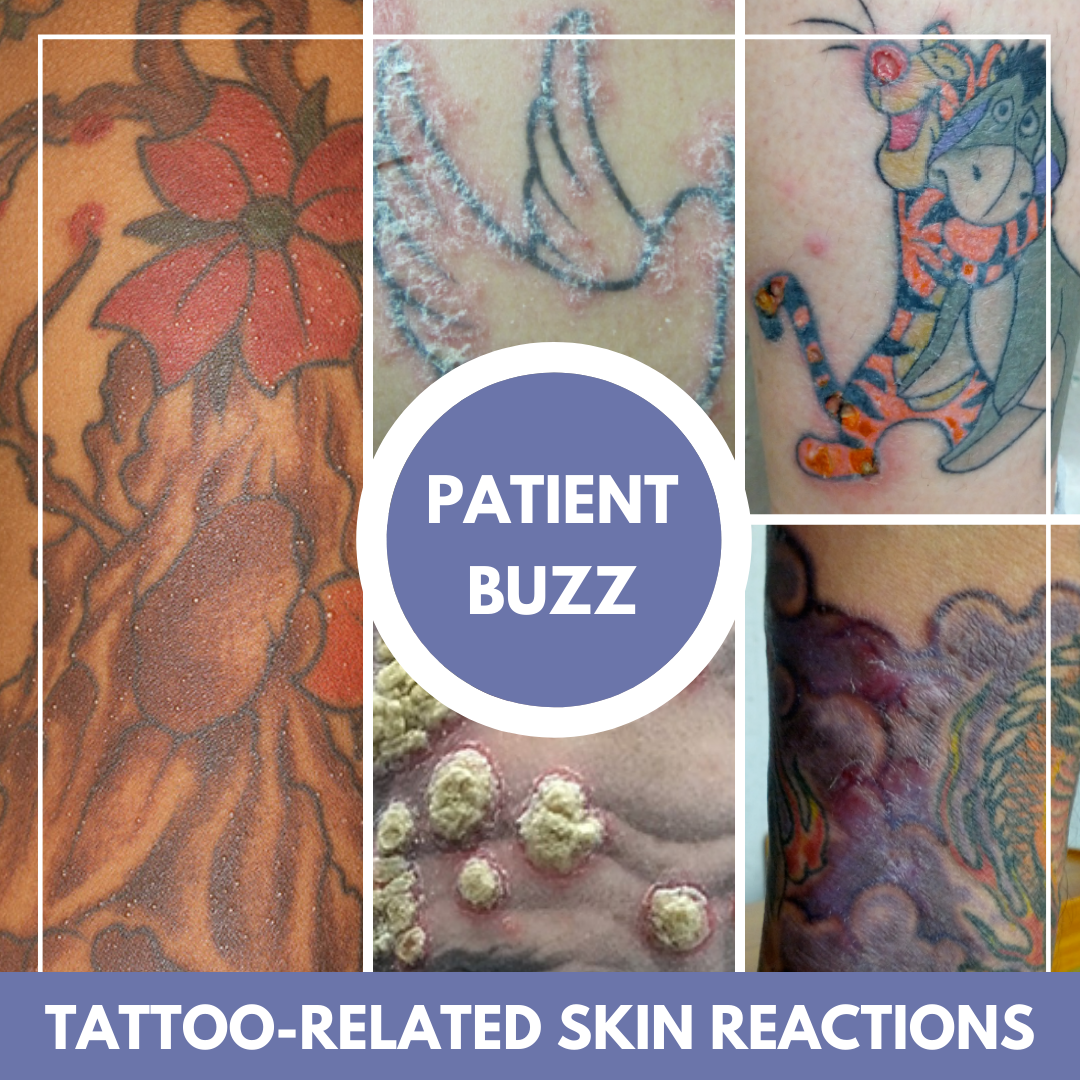Allure recently wrote an article about why tattoos can become itchy and raised. What common and uncommon skin reactions should dermatologists keep in mind when treating tattooed patients?
For an expert opinion, I contacted Rhode Island dermatologist Matthew Willett, MD, FAAD.
What common skin reactions can occur in people shortly after getting a tattoo?
The most common acute skin reaction associated with tattooing is an acquired hypersensitivity reaction to the tattoo ink, which may present as an eczematous, lichenoid, or pseudolymphomatous dermatitis within and immediately surrounding the tattoo. Tattoo pigments commonly contain metallic salts, such as cobalt and nickel, which are known contact allergens.
Red tattoo ink remains the most common ink color to present with a hypersensitivity reaction. Historically composed of mercuric sulfide (cinnabar), less reactive components, such as cadmium selenide (cadmium red), ferric hydrate (sienna), and other organic compounds, are now used.
Another unique skin reaction seen with tattooing is a photoallergic reaction. Typically eczematous in presentation, photoallergic reactions are most commonly seen with yellow ink (cadmium sulfide), red ink (cadmium selenide), and yellow-red (azo dyes).
Tattoos can, unfortunately, be associated with localized skin infection, often due to normal skin flora, such as Staphylococcus aureus. Less commonly, fortuitum complex mycobacteria, such as Mycobacterium chelonae, are seen and can present as inflamed subcutaneous nodules in a sporotrichoid pattern.
What issues can develop long after the tattooing process?
Frustratingly, many skin reactions secondary to tattooing may be delayed, often occurring even decades after the tattoo was performed. Delayed reactions include a granulomatous reaction within the tattoo, and as above, these may assume a pseudolymphomatous presentation. Such reactions are often misdiagnosed as human papillomavirus infection or even squamous cell carcinoma.
Development of sarcoidal lesions within tattoos is a commonly recognized phenomenon that often presents many years later. These may present as a characteristic ‘apple jelly’ nodule but may also masquerade as eczematous or lichenoid in presentation. Development of such sarcoidal change within a tattoo should prompt the dermatologist to investigate for any systemic manifestations of sarcoidosis.
What are some uncommon tattoo-related skin reactions that can occur, such as eruptive milia?

Uncommon dermatoses can rarely occur associated with tattoos, and the clinical presentation may often be bizarre. Case reports of eruptive milia within tattoos have been reported, thought to represent irritation to the follicular structure during tattooing. A morpheaform reaction has also been reported, but this may represent sequela of a long-term untreated eczematoid reaction.
Keratinocyte cancers, such as squamous cell carcinoma and keratoacanthoma, have been reported developing in long-standing tattoos, but the clinical presentation remains similar to those that appear de novo.
You co-authored a 2019 JDD case report on ostraceous psoriasis presenting as Koebner phenomenon after the patient received a tattoo. Can you explain how tattooing can activate certain dermatologic conditions? What are the key takeaways from this case?

Well-known to dermatologists, the Koebner phenomenon is most commonly associated with psoriasis but may occur in many different dermatoses, such as vitiligo and lichen planus. Any physical insult, from abrasions to sunburns, may induce areas of involvement. Psoriasiform Koebnerization has been reported in tattoos, in many cases being the initial presentation of disease. Patients with a known history of psoriasis or other dermatitis prone to koebnerization should be counseled to approach tattooing with caution.
What is your advice for dermatologists in recognizing tattoo-related skin reactions?
While initially eye-catching, tattoos may represent a ‘blind spot’ within the skin evaluation. It is important to evaluate for textural change, even within long-standing tattoos. While itching within the initial post-tattoo period is expected, sudden onset itching months to years after tattooing may represent an occult dermatosis. Melanocytic nevi may also reside within the tattooed area and may be obscured by darker overlying tattoo pigment. Dermatoscopic evaluation may allow the true pigment pattern to be evaluated, and nevi within tattoos should be specifically pointed out to the patient to aid in monthly home skin exams.
Early-onset post-tattoo dermatitis thought to be an eczematous reaction may be treated with both topical and intralesional corticosteroids, and the patient should be counseled to keep the area effectively moisturized. Late-onset dermatitis may often require a biopsy to confirm the diagnosis histologically, at which point targeted therapy may be directed.
What advice should dermatologists provide their patients who are considering getting a tattoo?
The most important advice that you can provide to a patient is to visit a reputable tattoo parlor that is known to use sterile techniques during the tattoo process. Don’t be afraid to ask the tattoo artist about these sterile techniques; a professional artist will be more than happy to talk through them with you. It is also important to follow all appropriate aftercare instructions for cleaning the new tattoo, as well as those to prevent delayed wound healing. You may additionally consider avoiding recreational water exposure immediately following getting a tattoo, as this remains a known vector for atypical bacterial and mycobacterial infections.
Certain patient populations should consider avoiding tattoos, such as those with a history of psoriasis or hypertrophic scarring. While new evidence suggests that non-ablative therapies are safe in patients currently taking isotretinoin, tattooing should be avoided due to a risk of poor wound healing.
Views expressed are those of Dr. Willett and do not reflect the official policy or position of the DON, DOD or USG.
Did you enjoy this Patient Buzz expert commentary? You can find more here.

